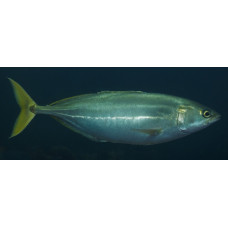Latin name
Atule mate
Other name
Northern yellowtail scad, one-finlet scad, deep trevally and omaka.
Identification
The body of the yellowtail scad is elongated, oval in shape, slightly compressed at the sides. Upper and lower body profiles slightly convex, similar in shape. The snout is pointed. Eyes of moderate size, their diameter being less than the length of the snout; almost completely closed by the fatty eyelid, leaving only a small vertical slit in the centre of the eye. The tip of the upper jaw extends to a vertical line passing through the anterior third of the eye. The teeth on both jaws are small, arranged in a single row; the anterior part of the upper jaw has 2-3 rows of small fang-like teeth. The first gill arch has 34-43 gill stamens, of which there are 11-13 gill stamens on the upper part and 24-30 gill stamens on the lower part. There are teeth villi on the vomer, palate and central part of the tongue. The lateral line forms a high arc in the anterior part and then continues straight to the caudal peduncle. The chord length of the curved part of the lateral line is 1-1.4 times the length of the straight part. The curved part has 39-57 scales; the straight part has 0-10 scales and 36-49 bony flaps. Vertebrae: 10 trunk vertebrae and 14 tail vertebrae.
Features of fish fins
Fish of this species have two dorsal fins. The first dorsal fin has 8 hard rays and the second has 1 hard ray and 22-25 soft rays. The anal fin has 1 barbed ray and 18-21 soft rays, with 2 barbs in front of the fin. The barbed dorsal fin is relatively high; the height of the longest barb is approximately equal to the height of the anterior soft ray of the second dorsal fin. The last soft ray of the dorsal and anal fins is elongated, about 2 times as long as the preceding rays, slightly separated from the other rays but connected to them by a membrane. The pectoral fins are long, crescent-shaped; the tip of the fin reaches the point where the curved part of the lateral line becomes a straight line when the fin is clamped. The edge of the secondary pectoral fin band (cleithrum) is smooth, without tubercles. The caudal fin is forked.
Fish colouring
The body of the Yellowtail Scad is bright olive green in the upper part, becoming yellowish-green on the sides and whitish in the lower part. There are 9-10 vertical grey stripes along the body, wider than the distance between them. There is a black spot on the upper edge of the gill cover, slightly smaller than the diameter of the eye. The dorsal and caudal fins are greenish-yellow; the anal fin is pale yellow; the pectoral and ventral fins are whitish.
Distribution
Widespread in the Indo-Pacific from South Africa along the coast of East Africa (including Madagascar and the Seychelles) to the Red Sea and Persian Gulf; further east along the coast of South and Southeast Asia to Indonesia and the Philippines; north to southern Japan; south to northern Australia and New Caledonia. Occurs in the central Pacific: French Polynesia, Hawaiian Islands.
Habitat
Marine pelagic fish. They live in coastal waters in shallow bays and mangroves at depths of 1-80 m, entering estuaries.
Size
The maximum body length of these fish is 30 cm, usually up to 26 cm. The body height is 26.4-31.4% of the standard body length.
Behavior
Yellowtail scad are found in small schools, sometimes solitary.
Food and feeding habits
Feeds during daylight hours; juveniles feed mainly on crustaceans, adults on fish and cephalopods.
Reproduction
Male and female Yellowtail Scad reach maturity at a length of about 17 cm. They spawn in April-May and January-February. Absolute fecundity varies from 63 to 161 thousand eggs.
Fishing
Commercial fish. Saudi Arabia catches most of these fish. It is caught using trawls, longlines and a variety of artisanal fishing gear.
Relationship with a person
Yellowtail scad are sold fresh, salted and dried.
| Classification | |
| Phylum | Chordata |
| Class | Actinopterygii |
| Squad | Carangiformes |
| Family | Carangidae |
| Genus | Atule |
| Species | A. mate |
| Features | |
| Conservation status | Least Concern |
| Habitat | Pelagic |
| Life span, years | No information |
| Maximum body weight, kg | No information |
| Maximum length, cm | 30 |
| Sailing speed, m/s | No information |
| Threat to people | Edible |
| Way of eating | Predator |
Yellowtail scad
Tags: yellowtail scad

